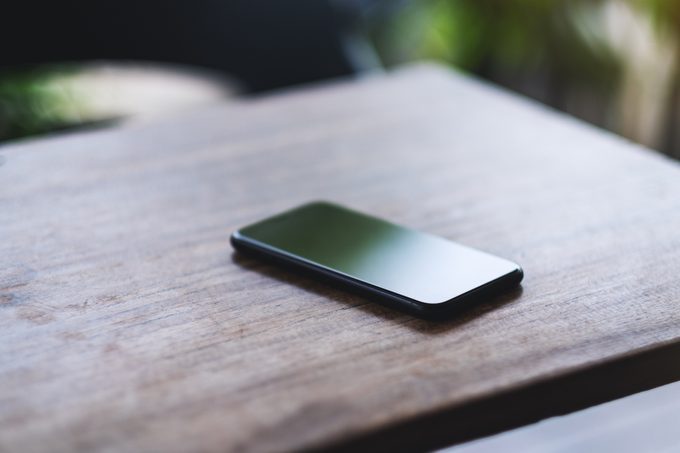Don't lose hope! You can still find a lost phone—even if it's turned off.

How to Find a Lost Phone That’s Turned Off

If you’ve lost your phone, don’t panic. Both Androids and iPhones have tools that allow you to locate your missing phone. That said, if your phone is turned off, things can be a little more complicated, especially for those with an Android. But help is on the way from Eric Florence, a cybersecurity analyst who knows just how to find a lost phone that is turned off. Keep reading to learn what to do if it happens to you.
Get Reader’s Digest’s Read Up newsletter for more tech, cleaning, travel, humor and fun facts all week long.
How to find a lost iPhone
The Find My iPhone tool is the best and easiest way to find your lost iPhone that is switched off or has a dead battery. (Emphasis on your—it’s illegal to track someone else’s phone without their consent.) You’ll need to go to Find My iPhone on iCloud.com to access the tool. Once you’re signed in on your iCloud, click on “All Devices.” Select your lost phone from the list. Then, you’ll see a map appear on the screen with the location of your phone.
How to find a lost Android phone
An Android phone can be found through the Android Device Manager. To ping and find your phone, simply go to the Find My Device site and log in using the Google account associated with your phone. If you have more than one phone, choose the lost phone in the menu at the top of the screen. Then, the location of your phone will appear on the map.
If the map shows that your phone is nearby, click on “Play Sound.” The device will ring for the next five minutes, even if it is set to silent, to help you trace its location.
Can you track a phone if it’s turned off?
iPhones can still be found even when your phone is turned off. If you use the location steps above, and your phone is offline, the map will show the last place the phone was before it went offline. The site will send you an email if/when your phone is turned on again. Just choose the “Notify me when found” option on the screen.
Unfortunately, Android phones must be on to be located using the steps above.
How can I lock my lost phone?
![]()
A lock screen on your phone is one of the best ways to keep your phone secure, advises Florence. Lost Mode iPhone and Lock my Phone in Android Device Manager can lock your phone so that nosy people, thieves or hackers can’t get access to your private photos, bank apps or other sensitive information.
If your iPhone is lost, you can lock your screen remotely, even if you don’t have a password set up. Here’s how:
-
Go to Find My iPhone.
-
Log in.
-
Click the device menu at the top of the screen.
-
Choose your lost iPhone.
-
Click “Lost Mode.”
-
Choose a contact number.
-
Click “Next.”
-
Type a message that you want someone to see if they find your phone.
-
Click “Done.”
For Android phones, the Find My Device tool will lock your phone and let you set up a password, PIN or pattern if you don’t already have one. Here are the steps:
-
Go to Find My Device.
-
Log in using the Google account that is associated with your phone.
-
If you have more than one phone, choose it in the menu at the top of the screen.
-
Click on “Secure Device.”
-
Type in a message and contact phone number that someone can see to contact you if they find your phone.
-
Click “Secure Device.”
About the experts
|
Why trust us
Reader’s Digest has published hundreds of articles on personal technology, arming readers with the knowledge to protect themselves against cybersecurity threats and internet scams as well as revealing the best tips, tricks and shortcuts for computers, cellphones, apps, texting, social media and more. We rely on credentialed experts with personal experience and know-how as well as primary sources including tech companies, professional organizations and academic institutions. We verify all facts and data and revisit them over time to ensure they remain accurate and up to date. Read more about our team, our contributors and our editorial policies.
Sources:
- Eric Florence, digital privacy expert at CyberInsider
- Google: “Find Hub”
- iCloud: “Find Devices”





















